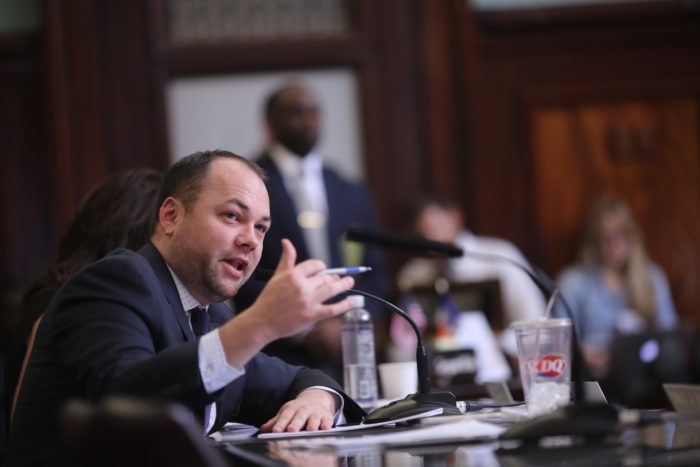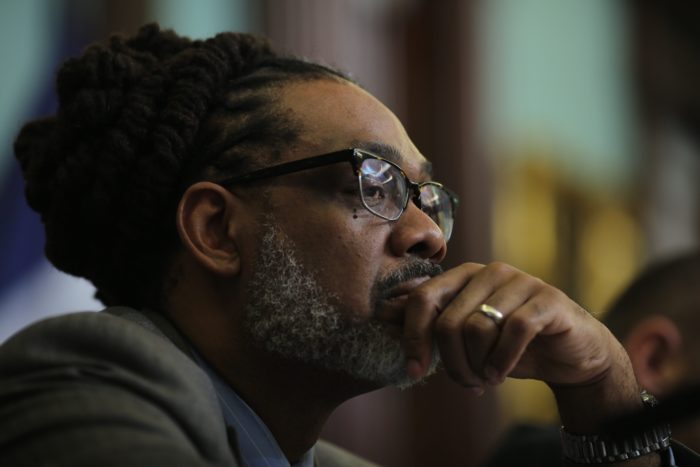There was a time when Brooklyn was the center of New York’s political universe.
We refer to that time by using the word “history.”
The County of Kings has long been the state’s largest, and when it came to power positions in the state and city legislature, Brooklyn was once almost literally the County of Kings.
Except for a short interval in 1968, Brooklyn held the top Democratic leadership position in the State Assembly steadily from 1930 to 1991, which meant that a Brooklynite held the Assembly speakership when the Democrats were in the majority (1935, 1965-68 and 1975-91). On the City Council, Brooklyn held the top position, then called majority leader, from 1938-61 and then again from 1969-85.
The last Brooklynite to serve as leader of the City Council was Thomas Cuite of Windsor Terrace, who was majority leader during that 16-year span ending in 1985.
In the last three decades, Brooklyn hasn’t had much luck at running the Council, directly or otherwise. And since losing the Assembly speakership in 1991 to a Brooklyn pol’s fraud conviction, the borough hasn’t managed to get it back.
Yes, our current mayor hails from Park Slope, but he is an exception to the rule. This week, Council member Corey Johnson of Manhattan is expected to be chosen as the new speaker, beating back several rivals including Council member Robert Cornegy Jr. of Brooklyn.

Council Member Corey Johnson of Manhattan is the favorite in this week’s election of a new speaker
The reasons for the decline of Brooklyn’s political machine vary. Some of it is the borough’s own factional warfare, although the worst factional warfare of the 1960s, between Stanley Steingut (an ally of Sen. Robert Kennedy) and Anthony Travia (aligned with Mayor Robert Wagner), didn’t ultimately stop both men from serving as Assembly speaker.
Some of of the blame can be put on ineffective leadership. Howard Golden, the Brooklyn borough president (1977-2001) and Democratic leader, thought himself a smart player, but got outplayed by kingmakers Donald Manes of Queens and Stanley Friedman of the Bronx. Manes and Friedman won themselves a Council speaker (Peter Vallone of Queens) and then got themselves arrested in practically the next moment (Manes made his first suicide attempt almost immediately after leaving Vallone’s victory party), leading one to conclude that maybe Golden was the more savvy survivor after all.
Golden’s successor, the hapless Clarence Norman, got the worst of both worlds, failing to win the leaderships and failing to avoid jail (a fate which also befell his candidate for the Council leadership). Norman’s successor, Vito Lopez, was far better than Norman at wielding an iron fist, but lacked such leadership skills as the ability to smile and say thank you.
And they all had bad luck.
The Lack of Leverage
So, what does that matter to us in Brooklyn?
Well, the speaker of the Assembly and the speaker of the Council, along with their top lieutenants, allocate resources, having control over various pots of funding and the ability to leverage others. Who gets what funding for which groups serving which neighborhoods is a large part of what a speaker decides.
To a great extent, legislative leaders decide whose quids get quo’ed. They decide which laws get passed and which don’t. They have large payrolls to work with. Council speakers approve every zoning change. Their pet projects often become those of the mayor and governor.
Robert Moses may have been the most powerful person in New York State in his day, but his desire to connect the Interboro Expressway to Brooklyn’s other highways still had to give way to Tony Travia’s desire not to see his neighborhood plowed over. As Travia had just helped Moses bury Mayor Lindsay’s plan to have the city take over Moses’ Triborough Bridge and Tunnel Authority, Travia had some leverage to assert.
Even a lesser leadership position in the right hands, leveraging influence properly, can change the city’s landscape. The Jacob Javits Convention Center exists today largely because State Senate Minority Leader Manfred Ohrenstein wanted it to.
Closer to home, we have Brooklyn Bridge Park today largely because of the cleverness of State Senate Minority Leader Martin Connor of Brooklyn Heights, working together with the chair of the Assembly’s Economic Development Committee, Eileen Dugan of Carroll Gardens.
So the fact that Brooklyn hasn’t held the Council leadership since 1991 and has rarely played a crucial role in choosing that leader has probably made differences to our lives and probably will do so again.
This is not always a bad thing. Not everyone loves the compromises inherent in how we got Brooklyn Bridge Park. Such compromises eventually played a crucial role in Connor’s political downfall. Some people don’t like Atlantic Yards (since renamed Pacific Park), a product of the best-buds relationship between former Brooklyn Borough President Marty Markowitz and former Mayor Bloomberg. The distance between one Brooklynite’s pet peeve and one Brooklyn pol’s pet project is often quite short.
City Council Intrigue
Brooklyn’s Council troubles began as 1985 turned to 1986, when a leadership vote took place to choose the new majority leader. The candidates were Vallone, backed by the members of the delegations from Queens, the Bronx and Staten Island, and Sam Horwitz of Brooklyn, backed by his home delegation and ostensibly that of Manhattan. If the boroughs had voted in that manner, the vote would have been 18-17 for Horwitz.
There were originally four candidates. The Brooklyn delegation was divided into factions loyal either to borough president Golden or his rival Tony Genovesi. There was always a question whether the Manhattan delegation would stick together. I was then chief of staff to Council Member Carolyn Maloney and remember the moment Carolyn told me that the Manhattan delegation had pledged to unite behind Horwitz. But as an alliance, it didn’t add up. The Upper East Side’s Robert Dryfoos was close with the Queens claque. I looked at Carolyn and asked, “Even Dryfoos?”
Just before the vote, the Manhattan delegation met at Maloney’s City Hall office. As the delegation members sat at a table, Council Member Stanley Michels asked the members one-by-one to raise their hand and pledge to cast their vote for Sam Horwitz. Dryfoos at first tried to paraphrase Barzini’s speech from the Godfather: “Look, we are all reasonable men here. We don’t have to give assurances as if we were lawyers.” But the two of them were lawyers and, arguably, none of them were reasonable. They all raised their hands to pledge and Dryfoos joined them.
A lot of good it did. They then walked across Chambers Street to City Hall. The roll call began, and when it got to Dryfoos, he pulled a typewritten speech out of his pocket and explained why he was voting for Vallone. More than a decade later, at a judicial induction in Brooklyn, Howie Golden was still angry enough to throw Dryfoos out of Borough Hall.
After the passage of a city charter change, Vallone’s title changed to council speaker and his power increased. In 2002, when he reached his term limit, the Queens and Bronx county leaders once again called the tune, and Manhattan’s Gifford Miller beat out Brooklyn’s Angel Rodriguez (who later copped a plea to trying to extort the developers of the Ikea store in Red Hook). Manhattan got the speakership, but most of the other plumbs ended up with the victorious bosses, with Queens getting the Chair jobs at both Finance and Land Use, the two most powerful committees.
In 2006, the same scenario ensued, as Manhattan’s Christine Quinn beat out Brooklyn’s de Blasio, with the Queens and Bronx string-pullers now being joined by Brooklyn boss Lopez (with a fragmented delegation, he had fewer votes to deliver) in a supporting role. As a result, Brooklyn got a slightly better cut of table scraps, though it wasn’t until Quinn’s second term that Brooklyn got the chair of the Finance Committee.
Rise of the Progressives
In 2014, Brooklyn threw a change-up.
The big three county leaders (Brooklyn, Queens and the Bronx) once again agreed that they would be the ones to determine which Manhattan member got to be speaker, and they chose Dan Garodnick. However, a rising Progressive Caucus, focusing on social justice, made deep inroads into every delegation and their Manhattan candidate, Melissa Mark-Viverito, made it a tight race with the support of newly elected Mayor de Blasio.
Brooklyn’s party leader, Frank Seddio, was playing with fewer cards than his outer-borough counterparts. Though Brooklyn is the largest borough, the Progressives had made the deepest inroads into his realm. But he decided to turn his weaknesses into strengths. The very fact Brooklyn had so many Progressives meant Seddio had had to develop strong working relationships with them, and those relationships included the new mayor.
Seddio decided to take a gamble: he would try to deliver his non-progressive loyalists to the mayor’s candidate, Mark-Viverito. If he lost, he would still have acquired a big chit with the mayor. Seddio took his shot and won, becoming the queen-maker. His ally, David Greenfield, became chair of the Land Use Committee. Frank Seddio became a lot more important, though for four years, the Queens and Bronx leaders have said nary a word to him.
The Current Race
As 2018 dawns, most of the Council Members have remained the same, but the lay of the land has shifted. Mark-Viverito has reached her term limit. The Progressive Caucus, hoping to produce her successor, ran into a roadblock when the mayor’s preferred candidate, Julissa Ferreras-Copeland, decided to move to Maryland with her family.
Seven members of the Progressive Caucus decided to run for speaker. In some ways this meant that there were seven out of eight chances that the speaker would be a Progressive. But in the only way that counted, it meant that none of them would be. All those candidates may have been Progressive, but there was no singularly strong Progressive candidate. The important unions, previously part of their coalition, fragmented their support. The county leaders again become crucial, but not the county leader who had been crucial the last time.

Brooklyn Council Member Robert Cornegy, who has the backing of the borough’s party leader
Seddio stuck with the mayor (who delayed in endorsing any particular candidate), but the mayor is now a lame duck and, in many ways, had worn out his welcome in the districts of many of the white members of the council. As a result, the Brooklyn members most likely to stick with Seddio were usually the ones least interested in sticking with the mayor.
By December, everyone could see that Seddio would not be the kingmaker again. Not one speaker candidate attended the Christmas party at Seddio’s home political club.
But Seddio played well the cards he was dealt. Seddio did a couple of large favors for Manhattan Democratic Leader Keith Wright, including siding with him on filling a State Senate vacancy. Meanwhile, Seddio lay in wait for a chance to make a smart move, occasionally taking the time to let people to know that his own preferred speaker candidate, Brooklyn’s Robert Cornegy Jr., might make a great compromise candidate. After all, Cornegy, a former pro-basketball player of towering height, was the only candidate the mayor would have to look up to.
Queens Party Leader Joe Crowley and the Bronx’s Marcos Crespo waited until the mayor was in Iowa to deliver their votes to Council member Corey Johnson, an openly gay white male from Christine Quinn’s old Chelsea district, who had carefully accumulated a strong bloc of votes on his own by a combination of aggressive campaigning and munificent largesse. Keith Wright joined with them and the mayor called to say “uncle” in as positive a manner as he could muster.
Seddio most likely is still smiling, having cemented his relationship with the lame duck who still has absolute power over many aspects of city government for the next four years. So perhaps the ju-jitsu master Seddio has still made the best of a bad situation. If Brooklyn could be said in 2006 to have won poorly, one might be able to argue that in 2018, it has lost very well.
But the vote hasn’t yet taken place and there are still three Brooklyn candidates in the race. Can anyone “pull a Dryfoos?” The short answer is no; the contest is over. So, what is this all about?
Race.
For the first time since 2005, the speaker will be a white male. In a majority-minority city, two of the three citywide officials are white males, and in a majority-minority Council, the new leader is a white male as well. With African-American votes having proven crucial to recent Democratic victories in Alabama and Virginia, some city leaders, like the Rev. Jacques Andre DeGraff, see this as “a slap in the face.”
“There’s a sense that black Democrats are not being supported by the establishment,” said Marc Morial, the head of the National Urban League.

Council speaker Mark-Viverito gave her state-of-the-city speech last year at Brooklyn’s Kings Theatre, but the borough’s current political influence doesn’t match the grandeur of the hall
Despite a liberal record, Cornegy, the only non-member of the Progressive Caucus to contest the race, was regarded by many as the most moderate, business-friendly candidate. Now his supporters, including political operative Charlie King, are saying things like, “There is no black political power in New York City. You cannot call New York City a progressive city when you have no black elected officials in positions of power,” said King.
Cornegy’s candidacy is joined in its lingering-on by that of fellow Brooklynite Jumaane Williams, one of the Council’s most left-wing members on economic and racial justice issues, who was so intent on becoming Speaker that he abandoned long held conservative positions on social issues. The move got him some favorable press, but no new votes.
The race’s last chapter seems even more quixotic for Williams than it is for Cornegy, who was seen during the speaker’s race as the best long-shot choice, with a plausible scenario for victory. Some are now seeing the lack of concession by Cornegy and Williams as a move to ensure a better price in bargaining chits for the eventual unity photo. Hence the new candidacy of Inez Barron, who has promised to fight until the bitter end even if Cornegy and Williams both fold and even if the only vote she receives is her own.
So, there will be no Brooklyn speaker, but do the three Brooklyn candidates and their supporters have a point? It depends on how you look at it.
The Council members who choose the speaker are majority non-white. Though Queens Leader Joe Crowley is white, he represents a Latino-majority district in Congress and his county organization installed Queens’ first black borough president and its first Asian member of Congress.
And Crowley couldn’t have picked a winner without the support of the Bronx leader Marcos Crespo, a Latino, and the Manhattan Leader, Keith Wright, an African-American whose father was civil-rights pioneer Judge Bruce Wright.
While it is true the proportions of minority power positions in the city can currently be called low, the arc of history has bent toward diversity. We’ve had a black mayor, we have a black public advocate, and we’ve had two comptrollers of color, one of whom was African-American. The current mayor holds his post because he first won nomination by beating a black candidate among black voters.
We’ve never had a black speaker, but the outgoing speaker is a Latina, as is the Finance Committee chair. Likely, one or both of the incoming Finance and Land Use chairs will be minority members, which the Cornegy/Williams moves are probably meant to ensure.
The current lineup of legislative-leadership positions in New York State offers a different picture. The most powerful Democrat in the state, other than the governor, is Assembly Speaker Carl Heastie of the Bronx, who is African-American. The Democratic Party leader in the legislature’s other house is State Senator Andrea Stewart-Cousins of Yonkers, an African-American. Her last three predecessors were also African-Americans, one of whom eventually become governor.
While African-American leaders have reason to be disappointed in the results of the contest for Council speaker, it can still be argued that holding two of the three top Democratic legislative positions is a sign of strength rather than weakness.
At any rate, it would appear that if one is trying to elect an African-American City Council speaker, or any speaker at all these days, one is best off finding a candidate who comes from a place other than Brooklyn–at least until the borough gets its political mojo back.